- home
- BAKERECIPES
BakeRecipes
Bringing real baking into your home with deliciously simple recipes.
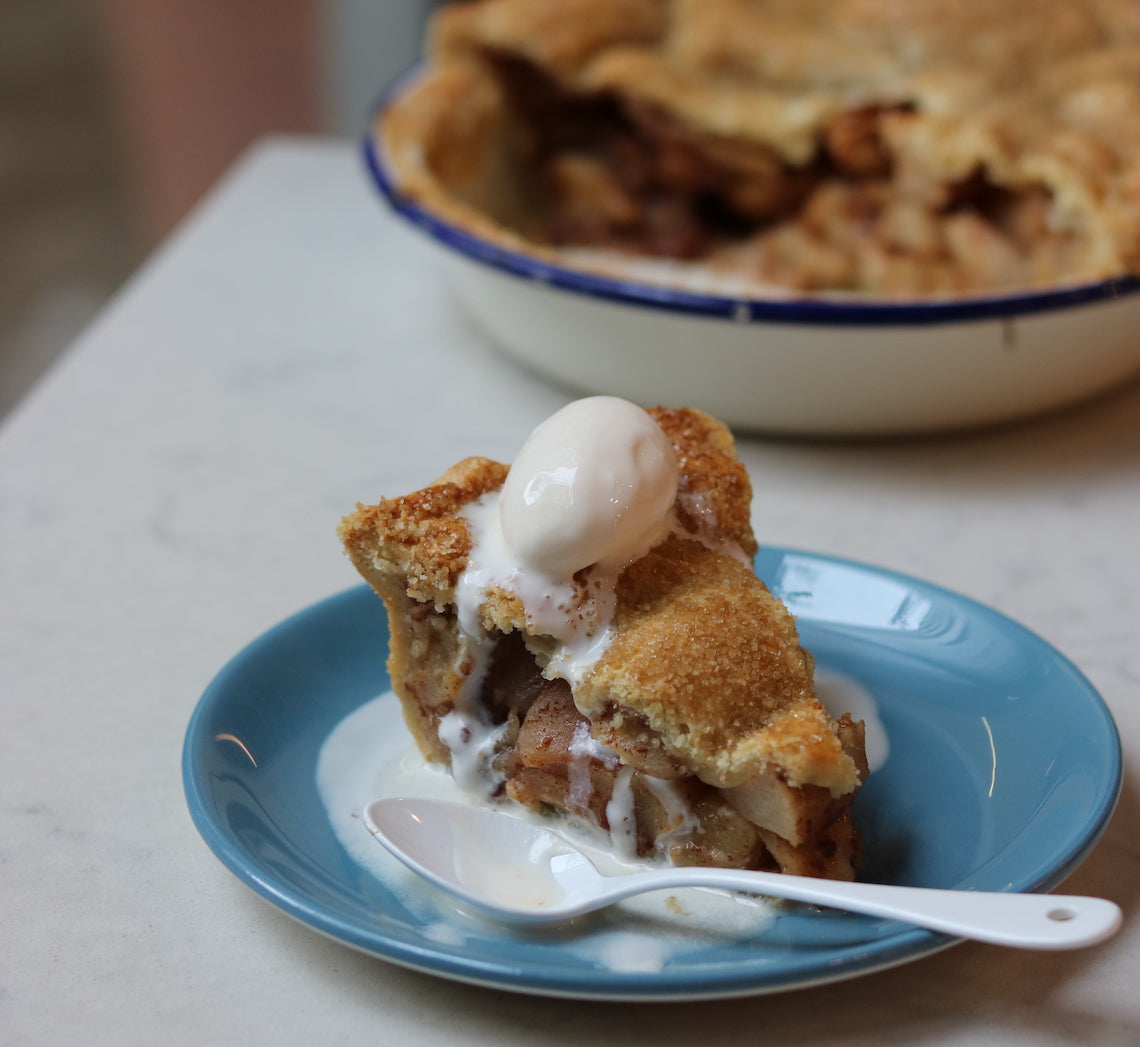
Prep 30min (+pastry making time)Bake 1hr15minMakes 8-10 serves
Everyone loves a classic apple pie – it is the ultimate comfort food... Especially when teamed with some good vanilla ice cream!
Ingredients
2 quantities Sweet Vanilla Shortcrust Pastry (combine ¼ of one pastry quantity with the other, and then shape each into a separate disc before wrapping and chilling for 30 minutes)
1 egg yolk
2 teaspoons milk
1 tablespoon demerara sugar
Vanilla ice-cream, to serve
Apple Filling
2½ tablespoons caster sugar
1½ tablespoons plain flour
1½ teaspoons ground cinnamon
6 medium (about 140g each) pink lady or granny smith apples
1 orange, rind finely grated and juiced
1 teaspoon vanilla bean paste
25g (¼ cup) almond meal
20g salted butter, finely diced
Method
- Preheat the oven to 200°C (180°C fan-forced).
- Unwrap the larger portion of pastry and place on a lightly floured, cool benchtop. Use a lightly floured rolling pin to roll the pastry into a round, about 5mm thick and about 35cm in diameter.
- Carefully drape the pastry loosely around the rolling pin, place it over an ungreased 20cm (top measurement) metal or ceramic pie dish (see Baker’s Tips) then unroll the pastry being careful not to stretch it. Gently lift the edges of the pastry and ease it into the pie dish to line the base and the sides and settle it into the corners without stretching it, allowing the excess pastry to overhang the edges. Place the lined pie dish on an oven tray and then place in the fridge to rest for while making the filling.
- To make the apple filling, combine the sugar, flour and cinnamon in a small bowl. Peel, core and quarter each apple. Cut each apple quarter into 4 wedges and place in a separate large bowl with the orange rind, 1 tablespoon of the orange juice and the vanilla bean paste. Use your hands or spatula to toss gently to evenly coat the apple slices. Add the sugar mixture and toss gently to combine evenly.
- Sprinkle the almond meal over the base of the chilled pastry case, spoon the apple mixture over the top and dot with the diced butter. Whisk together the egg yolk and milk. Brush the edge of the pastry with the egg wash. Roll out the remaining smaller disc of pastry into a round, about 5mm thick and about 25cm in diameter. Use a 2cm fluted or plain round cutter to cut out a circle from the centre of the pastry. Carefully drape the pastry loosely around the rolling pin and roll over the top of the pie. Use your fingertips to press the pie pastry top and bottom together around the edge of the pie to seal. Use a small sharp knife to trim the excess pastry from around the edge. Use your fingertips to pinch the edge of the pastry to decorate. Brush the top of the pie with some of the remaining egg wash and then sprinkle with demerara sugar.
- Bake in preheated oven for 30 minutes. Reduce the oven temperature to 160°C (140°C fan-forced) and bake for a further 40 minutes or until the pastry is golden and cooked through and the apples are tender (see Baker’s Tips). Remove the pie from the oven and stand for 5 minutes before serving warm with ice cream.
Baker's Tips
- For this recipe you will need a ceramic or metal pie dish measuring about 20cm across the top, 17cm across the base and 4.5cm deep.
- To check if the apples are tender, insert a skewer into the centre of the pie.
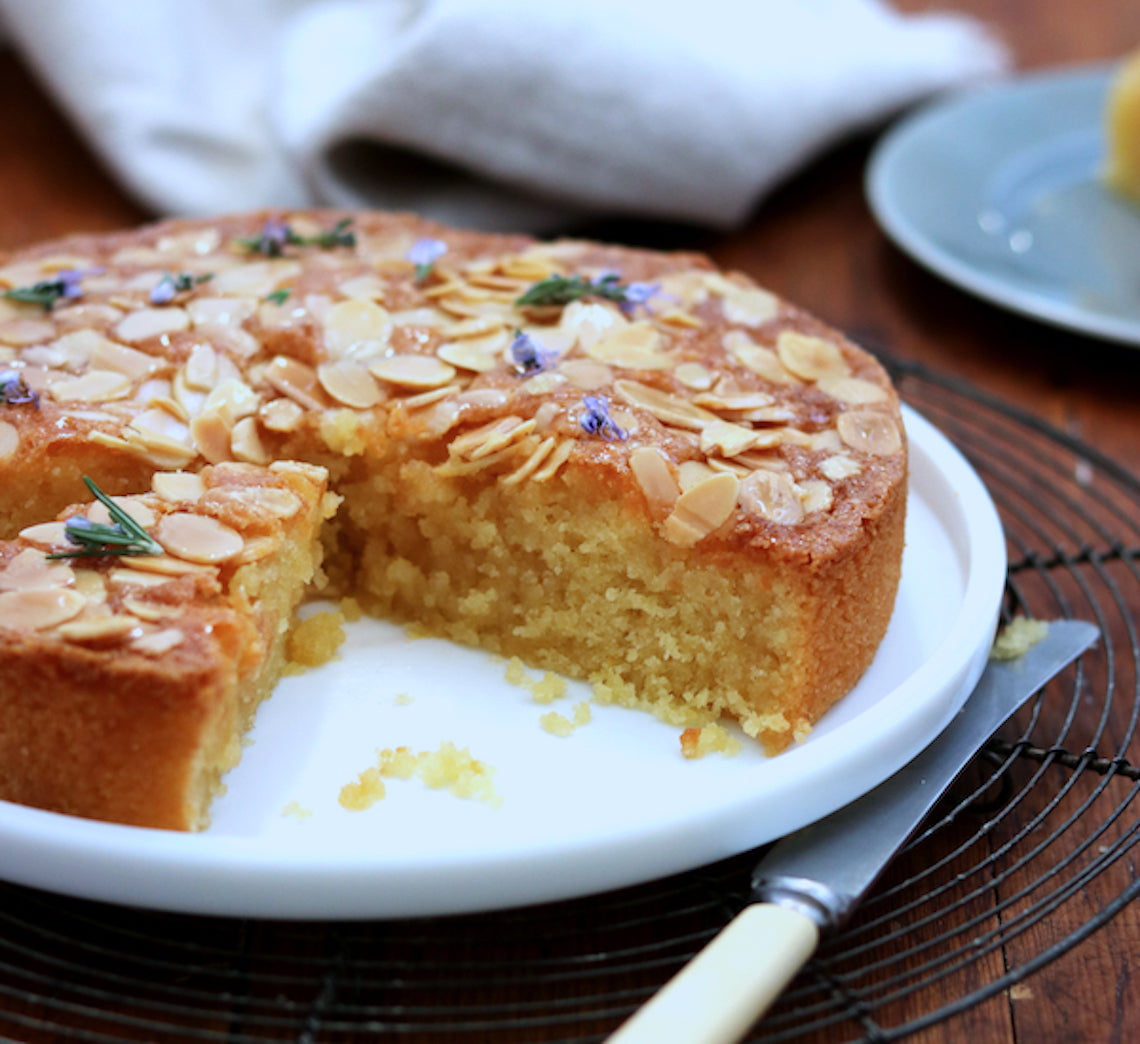
Prep 20min(+ 1hr cooling time)Bake 35-40minMakes 10 serves
Inspired by the wild rosemary found growing on the Gallipoli peninsula and the symbolic wearing of sprigs as a sign of remembrance for those who have made the ultimate sacrifice, this cake is the perfect way to pay your respects through your baking on Anzac Day. It's a simple cake, made special by the rosemary-infused syrup and is equally good accompanied by a cup of tea or lashings of cream or vanilla ice-cream for dessert (particularly when served while still warm)!
Ingredients
Olive oil, to grease
150g (5¼oz) caster sugar
125g (4½oz) almond meal
75g (½ cup/2¾oz) self-raising flour
180ml (¾ cup/6fl oz) olive oil
3 eggs, at room temperature
2 lemons, rind finely grated
40g (1½oz) flaked almonds
Fresh rosemary flowers (optional), to decorate
Lemon & Rosemary Syrup
60ml (¼ cup/2fl oz) strained fresh lemon juice
60ml (¼ cup/2fl oz) water
110g (½ cup/4oz) caster sugar
4 x 10cm sprigs fresh rosemary
Method
- Preheat oven to 180°C/350°F (160°C/315°F fan-forced). Brush a 20cm/8in spring form tin with olive oil and line the base with non-stick baking paper.
- Combine the sugar, almond meal and flour in a large bowl. Whisk together the olive oil, eggs and lemon rind until well combined. Add to the almond meal mixture and use a balloon whisk or spatula to stir until just evenly combined.
- Pour into the prepared tin and spread with the back of a spoon. Sprinkle evenly with the flaked almonds. Bake in preheated oven for 35-40 minutes or until a skewer inserted in the centre comes out clean. Stand the cake in the tin for 5 minutes before turning transferring to a wire rack sitting over a tray.
- Meanwhile, to make the Lemon & Rosemary Syrup, combine the lemon juice, water and sugar in a small saucepan and stir over medium heat until the sugar dissolves. Add the rosemary sprigs, bring to a simmer and simmer for 5 minutes or until reduced by about half.
- Slowly pour the hot syrup over the warm cake, allowing it to soak in as much as possible. Cool to room temperature (this will take about 1 hour). Decorate with the rosemary flowers (if using) and serve in slices.
Baker's Tip
- This cake will keep in an airtight container at room temperature in a cool spot for up to 3 days.

Prep 30min (+ 1hr proving time)Bake 15-18minMakes 4 serves
This is a terrific pizza recipe and it's particularly fun to make with kids. It has become a favourite in our house and when the kids were younger it was a regular fixture for Friday night dinner, when their friends would come for a play and early dinner. Together we would knead and roll the dough, then top it, bake it and eat it. They loved it and I'm sure you will too!
Ingredients
Dough
450g (3 cups) strong bread or pizza flour, plus extra to dust
1 x 7g sachet instant dried yeast
1½ teaspoons salt
310ml (1¼ cups) lukewarm water
1 tablespoon olive oil
Pizza Sauce
1 tablespoon olive oil
½ brown onion, finely diced
1 garlic clove, crushed
½ teaspoon dried oregano
400g tin diced tomatoes
½ teaspoon sugar, or to taste
Salt and freshly ground black pepper, to taste
Topping
270g bocconcini, cut into 1cm-thick slices or torn into chunks
160g semi-dried tomatoes or 200g cherry or grape tomatoes (halved or quartered if large)
8 think slices prosciutto
50g rocket leaves
Freshly ground black pepper, to taste
Extra virgin olive oil, to drizzle
Method
-
To make the dough, combine the flour, yeast and salt in a large bowl and make a well in the centre. Combine the water and oil, then add to the flour mixture. Use a wooden spoon and then your hands to mix to a soft dough.
-
Turn the dough onto a lightly floured bench top and knead for 8-10 minutes, adding as little extra flour as possible, or until it is smooth and elastic and springs back when you push your finger into it.
-
Place the dough in an oiled bowl, turning it to coat lightly with the oil. Cover with plastic wrap and place in a warm, draught-free place for 1 hour or until doubled in size.
-
Meanwhile, to make the Pizza sauce, put the olive oil and onion in a medium saucepan over medium heat and cook, stirring occasionally, for 8 minutes or until the onion is tender. Add the garlic and oregano and cook for 1 minute or until aromatic. Add the tomatoes and bring to the boil. Reduce the heat to low and simmer for 15-20 minutes, stirring occasionally, or until thickened to a thick sauce consistency. Remove from the heat and season with sugar, salt and freshly ground black pepper, to taste. Set aside to cool.
-
Preheat the oven to 230°C (210°C fan-forced).
-
Knock back the dough by punching it in the centre with your fist. Turn onto a lightly floured bench top and knead briefly until reduced to its original size. Divide the dough into 2 equal portions. Roll out one portion on a piece of non-stick baking paper large enough to line a large heavy oven tray to a rectangle about 3mm thick. Transfer to the tray and prick all over with a fork. Repeat with the remaining dough and another piece of non-stick baking paper and large oven tray.
-
Spread the pizza bases with the pizza sauce leaving a border around the edge. Top with the bocconcini and semi-dried tomatoes (if using), dividing evenly. Bake in preheated oven for 15-18 minutes, swapping the trays after 8 minutes, until the bases are crisp, golden and cooked through.
- Remove from the oven, cut into portions and serve topped with the fresh tomatoes (if using), prosciutto and rocket, sprinkled with freshly ground black pepper and drizzled with a little olive oil.
Photography by Julie Renouf.
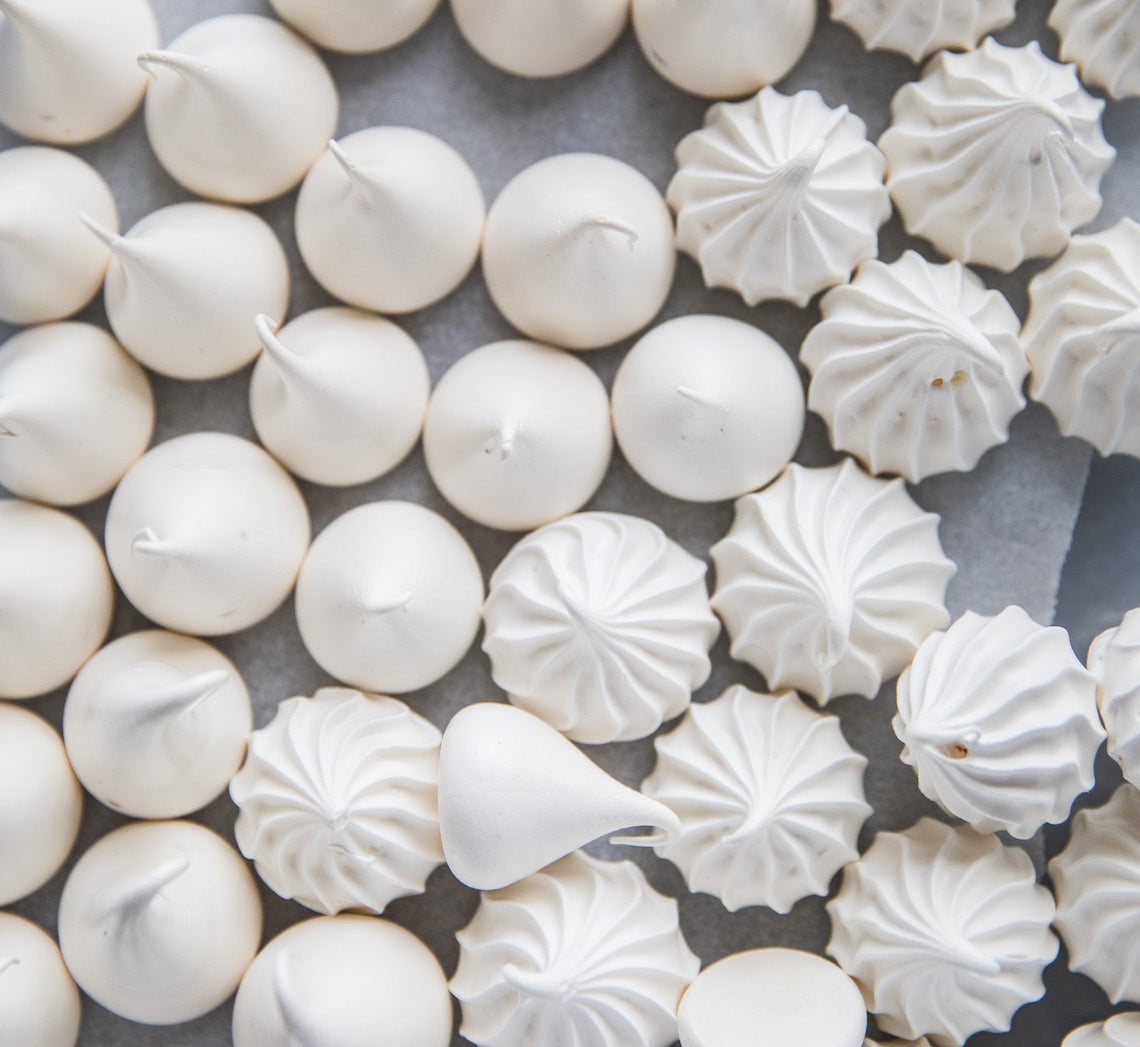
Prep 40min (+1-2hr cooling time)Bake 1hr-1hr10minMakes about 50
Ingredients
2 egg whites (from 60g/2oz eggs)
110g (½ cup/4oz) caster sugar
1 teaspoon natural vanilla essence or extract
2 teaspoons gluten-free cornflour, sifted
Method
- Preheat oven to 110°C/230°F (90°C/195°F fan-forced). Line an oven tray with non-stick baking paper.
- Combine the egg whites and sugar in a medium heatproof bowl (preferably metal) and place over a saucepan of simmering water, ensuring the bowl doesn’t touch the water. Stir with a spatula or small whisk until the sugar dissolves and the mixture is hot to touch (about 55-60°C on a sugar thermometer). Be careful not to allow the egg whites to cook.
- Transfer the egg white mixture to the bowl of an electric mixer (see Baker’s Tips). Whisk the egg white mixture with a whisk attachment on medium-high speed until very thick and glossy and the mixture has cooled to room temperature. Whisk in the vanilla and cornflour.
- Fill a large piping bag fitted with a 4B star (or #11/11mm/½in round) piping nozzle with the meringue mixture. Holding the piping nozzle about 1cm/½in above the tray, pipe small rosettes (or 'kisses') about 2.5cm/1in in diameter and 2cm apart on the lined tray.
- Bake in a preheated oven for 60-70 minutes or until the meringues are crisp, hard to touch and peel away from the tray easily, but are not coloured.
- Remove the meringues from the oven and place immediately in an airtight container lined with absorbent paper
Variations
- Striped Meringue Kisses: Use a paintbrush to lightly brush evenly spaced vertical lines of food colouring gel on the inside of the large piping bag before spooning the meringue mixture into the piping bag. Continue as per the recipe.
Baker's Tips
- The fan-forced setting is often too intense for baking meringues and will cause them to crack. If this is the case with your oven, opt for the conventional setting. However, if the meringues do crack when using the convention setting, your oven may be running a little hot and next time reduce the temperature by 5-10°C (41-50°F) as this will often help prevent them from cracking.
- If you don't have a small bowl for your mixer, first whisk the egg white mixture with a balloon whisk until it is foamy and doubled in volume before whisking with the stand mixer. This will make the whisking of the egg white mixture more efficient in a standard size bowl.
- Allowing the egg white mixture to come to room temperature before whisking will reduce the time it will take to whisk it to a meringue.
- These meringues will keep in an airtight container at room temperature for up to 1 week.
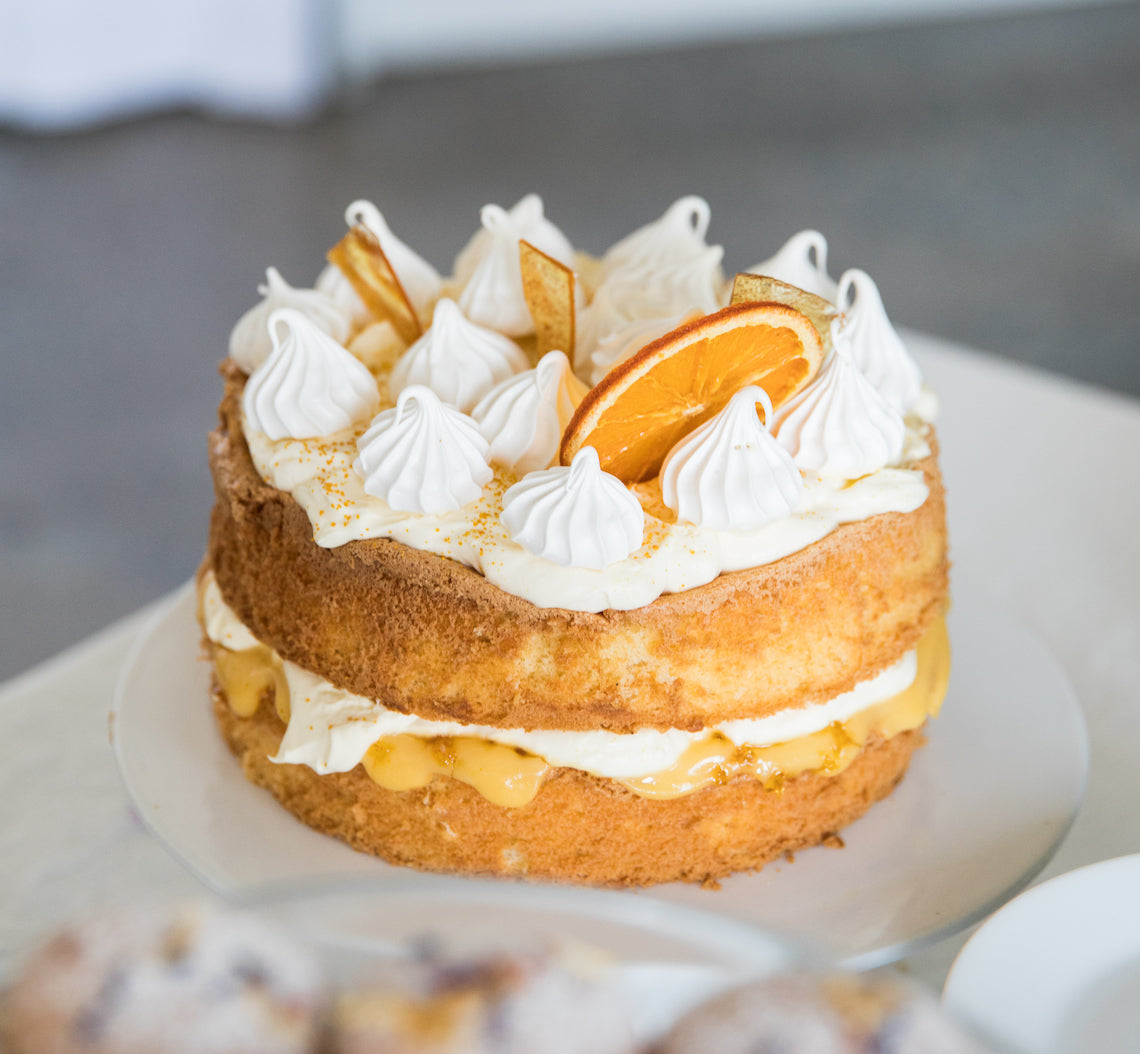
Prep 1.5hr (+ Meringue Rosettes prep)Bake 18-20minMakes 8-10 serves
An absolute must-try for any citrus fan, this light-as-air cake is the ultimate balance between light sponge, mouth-puckering lemon curd and beautiful hand-made adornments.
Created by Make Me a Baker student, Cate Tibbertsma for her graduation, this cake is a nostalgic one "that will fill your belly with sweet memories" as Cate says.
Ingredients
125ml (½ cup) thickened cream
125g (½ cup) sour cream
1 tablespoon pure icing sugar, sifted
1 teaspoon Citrus Dust (see recipe below), plus extra to sprinkle
Meringue Rosettes (get Cate's meringue recipe HERE), to decorate
Oven-dried orange slices (optional), to decorate
Lemon Curd
2 eggs, at room temperature
2 egg yolks, at room temperature
165g (3/4 cup) caster sugar
80g unsalted butter, diced
2 lemons, zest finely grated and juiced
Sponge Layers
Melted butter to grease
4 fresh eggs, at room temperature
1½ teaspoons natural vanilla essence or extract
165g (3/4 cup) caster sugar
60ml (1/4 cup) milk
30g butter, diced
110g (3/4 cup) self-raising flour
30g (1/4 cup) cornflour
Citrus Syrup
110g (½ cup) caster sugar
60ml (1/4 cup) strained fresh lemon juice
60ml (1/4 cup) strained fresh orange juice
Citrus Toffee Shards
Oil spray
100g caster sugar
2½ tablespoons water
1 tablespoon liquid glucose
½ teaspoon Citrus Dust (see recipe below), to sprinkle
Lemon Curd
- Combine the whole eggs, yolks and sugar in a small saucepan and stir with a whisk until smooth. Add the butter and the lemon juice and zest.
- Place the saucepan over a low heat and stir constantly with the whisk until thickened and the mixture reaches 75°C on a sugar thermometer.
- Strain through a sieve into a sterilised jar or glass container with lid. Refrigerate until required (see Baker’s Tips).
Citrus Toffee Shards
- Line a baking tray with non-stick baking paper and spray lightly with oil; set aside. Combine the caster sugar, water and the liquid glucose in a small saucepan. Stir over a low heat until the sugar dissolves. Stop stirring when it starts to boil and brush down the inside of the saucepan with a wet pastry brush to dissolve any crystals that have formed on the surface. Boil until the syrup turns a dark caramel colour (see Baker's Tips).
- Immediately pour the caramel over the entire surface of the baking sheet to create a thin layer. Sprinkle with the Citrus Dust. Set aside to cool and set. When completely cool, transfer to a sealed airtight container together with the baking paper.
Sponge Layers
- Position the oven rack in the middle of the oven and then preheat it to 180°C (160°C fan-forced). Brush two 18cm springform tins with melted butter to grease and line the base of each with a sheet of non-stick baking paper. Combine butter and milk in a small saucepan and set aside. Combine the Citrus Syrup ingredients in a separate small saucepan and set aside also.
- Use an electric mixer with a whisk attachment on medium-high speed to whisk the eggs and vanilla in a medium bowl until frothy. Add the sugar a spoonful at a time, whisking well between each addition, until the mixture is very thick and pale and the sugar has dissolved (this will take about 8 minutes). Lift the whisk out of the mixture and slowly draw a figure eight, if the trail stays on the surface long enough for you to finish drawing then the mixture is ready. If not, continue to whisk for a further minute and then test again.
- Meanwhile, heat the milk and butter in a small saucepan over medium heat until the butter melts and the mixture is almost simmering. Remove from the heat. Pour the hot milk mixture down the side of the bowl and then sift the flour and cornflour together over the egg mixture. Immediately whisk briefly again with the electric mixer on low speed, until the flour mixture is just incorporated (make sure there is no flour caught at the bottom of the bowl and be careful not to over mix).
- Divide the mixture evenly between the cake tins (see Baker's Tips) and gently tap the tins on the bench top three times to settle the mixture. Bake in preheated oven for 18-20 minutes or until the cakes are a pale golden colour, spring back when lightly touched in the centre and start pulling away from the sides of the tins.
Citrus Syrup
- About 5 minutes before the Sponge Layers finish baking, place the saucepan with the Citrus Syrup ingredients over a medium heat and stir until the sugar dissolves. Bring to a boil then reduce to a very gentle simmer to keep warm.
- Remove sponges from the oven and immediately use a small palette knife to loosen the top of the sponges from the tins and turn onto a wire rack lined with a tea towel. Remove the baking paper and carefully turn the hot sponges back on their base onto a rack over a tray. Immediately pour hot syrup over the hot sponge layers. Set aside to cool completely before layering.
To Assemble
- Use an electric hand mixer with a whisk attachment or a balloon whisk to whisk the thickened cream, sour cream and icing sugar together in a medium bowl, until soft peaks form.
- Place one sponge layer on a serving plate or cake stand. Spread about 1/2 cup of curd over the sponge layer and use a small sieve to sprinkle the Citrus Dust over the curd. Spread about half the cream mixture over the curd layer, spreading gently to avoid over-working the cream. Top with the remaining sponge layer. Spread another 1/2 cup of curd on top followed by the remaining cream mixture, again spreading gently so you don’t over work it.
- Decorate with the Meringue Rosettes and Citrus Toffee Shards and sprinkle with extra Citrus Dust. Embellish with oven-dried orange slices, if desired. Serve immediately or refrigerate for up to 2 hours (see Baker's Tips).
ORANGE CITRUS DUST: Preheat oven to 100°C (80°C fan-forced). Use a vegetable peeler to peel the rind from 1 large orange. Use a small knife to scrap any excess pith away. Place on a lined oven tray and bake in oven for 1-2 hours. Rind is ready when it has dried completely but still retains some of its original colour. Use a mortar and pestle or a small food processor to pound or process the rind to a fine powder that is aromatic and rich in colour. Store in an airtight container in a cool dry place for up to one month.
Baker's Tips
- The Lemon Curd will keep in a sealed clean, sterilised jar for up to 2 weeks in the fridge. My preference is to make and refrigerate the lemon curd 1-2 days in advance of using it so that the curd thickens and the flavour develops.
- As the Citrus Toffee Shards syrup begins to darken, gently turn the pan to encourage the colour to spread but avoid swirling the mixture too vigorously to prevent the mixture from crystallising.
- The Citrus Toffee Shards will store at room temperature in an airtight container for up to a month, depending on the humidity.
- Having your butter and milk mixture for the Sponge Layers and the Citrus Syrup ingredients in separate saucepans, ready for heating, will make the preparation of this recipe more efficient and with help with the timing of when the different elements need to be ready.
- To divide the mixture evenly between the tins, weigh the tins with the mixture in them to make sure they are the same weight. Placing a small upturned bowl on the scale and for the cake tin to sit on will mean that the measurement display window can be easily viewed.
- Even though this cake is best eaten on the day it is baked, the unfilled syrup-infused sponge layers can be made the day before serving. Store in an airtight container at room temperature. To avoid the layers sticking to each other, separate the sponges with a layer of baking paper or store in two separate airtight containers. An upturned cake tin, larger than the diameter of the cake, also makes a useful barrier for separating sponges for storing.
- To ensure this cake cuts easily, resist over-filling the middle layer of curd and cream and, if possible, chill the assembled cake for a few hours before serving. Decorate with the meringues, toffee shards and citrus dust just before serving.

Prep 11/2hr (+ standing time) Bake 15min (per batch) Makes about 28
Pretty to look at, divine to eat, these macarons were created by Allen Au, one of our Make Me a Baker graduates, to use as part of his Graduation cake recipe.
Ingredients
125g almond meal
125g pure icing sugar
96g egg whites
125g caster sugar
30ml water
Gel colouring (see Baker's tip)
Filling
125g unsalted butter
125g pure icing sugar, sifted
1 tablespoon sieved cherry jam
Method
- Preheat oven to 165°C (145°C fan-forced). Line two large oven trays with non-stick baking paper or silicone baking mats.
- Sift together the almond meal and icing sugar into a large bowl. Add half the egg white and mix until a thick paste forms.
- Combine the caster sugar and water in a small saucepan and stir over medium heat until the sugar dissolves. Bring to a boil and simmer over medium heat, brushing down the sides of the saucepan with a wet pastry brush occasionally to prevent any sugar crystals forming. Do not stir. Once the sugar mixture has reached 115°C on a sugar thermometer, use an electric mixer with a whisk attachment to whisk the remaining egg white on medium-high speed until soft peaks form. Once the sugar mixture has reached 118°C, remove the saucepan from the heat and slowly whisk the hot sugar mixture into the egg whites. Continue to whisk on medium-high speed until the temperature cools to 30°C. The meringue should be thick and glossy. Add enough gel colour to the meringue to tint to the desired colour, whisking until evenly combined.
- Fold 2 large tablespoons of the meringue into the almond paste mixture until well incorporated. Fold in the remaining meringue until evenly combined. The consistency of the batter should look like molten lava. If you can draw a figure eight and the trail stays on the surface, then the mixture is ready to be piped.
- Spoon the mixture into a piping bag fitted with a 10mm round nozzle. Pipe the macarons onto the lined trays into 3.5cm rounds. Tap the tray to remove any air bubbles from the macarons. Leave the macarons out in the open until a skin forms on the surface of the macaron. (This can take from 20 minutes to an hour depending on the humidity). The skin should be dry enough that it does not stick to your finger when touched lightly.
- Bake one tray of macarons in the centre of the preheated oven for 15 minutes or until shells don't feel soft at the 'feet' when touched. Set aside to cool on the tray and repeat with the remaining tray of macarons.
- To make the Filling, use an electric mixer to beat the butter until it is pale and creamy. Beat in the icing sugar until well combined. Add the cherry jam and beat until well combined. Spoon the filling into a piping bag fitted with a 7mm star nozzle and pipe a small rosette onto the base of half the macarons. Sandwich with the remaining macarons.
- Store the macarons in the fridge overnight so the flavours from the filling are absorbed by the shells. Bring the macarons to room temperature before serving.
Baker's Tips
- Allen used Chefmaster Liqua-Gel colours to colour his macarons – he used 8 drops of Super Red with 0.5 drop of Black Diamond
- This recipe is based on a recipe from a course Allen did with Australian Patisserie Academy
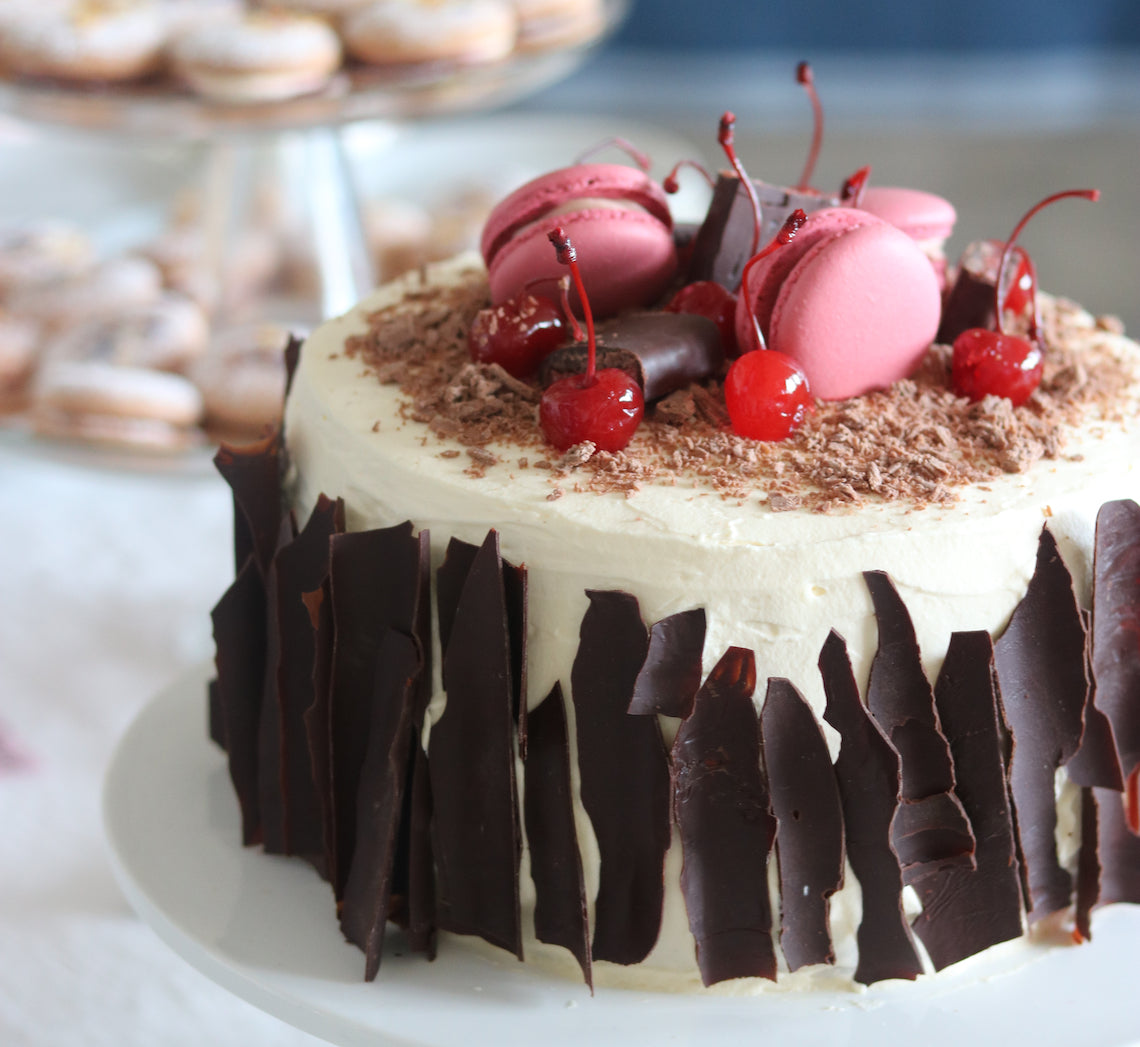
Prep 11/2hr (+ macaron prep)Bake 18-20min (per batch)Makes 10 serves
Created by Make Me a Baker student, Allen Au for his graduation, this cake is certainly a show stopper.
Before starting the program Allen had always found making sponge cakes challenging and had almost given up on ever making another again. But, he set himself the challenge of perfecting a sponge and creating a version of Black Forest cake that his wife had always wanted him to. The result was a modern cake bursting with flavour and showcasing Allen's newly-acquired baking skills!
The sponge cake in this recipe is a version of the one students learn to make during the Make Me a Baker program.
Ingredients
Chocolate Sponge Cake (2 layers)
Melted butter, to grease
4 eggs, at room temperature
150g caster sugar
60ml milk
30g salted butter
110g self-raising flour
30g cocoa powder
Chocolate Sponge Cake (1 layer)
Melted butter, to grease
2 eggs, at room temperature
75g caster sugar
30ml milk
15g salted butter
55g self-raising flour
15g cocoa powder
Kirsch Syrup
80g caster sugar
90ml water
60ml kirsch
To Assemble
900ml thickened cream
200g cherry jam
1½ x 680g jars pitted Morello cherries, drained
To Decorate
Chocolate bark (see Baker's tips)
10 Maraschino cherries with stems, drained
2 Cadbury Cherry Ripe double-dipped chocolate bar, cut into 3-4 pieces
1½ Cadbury Flake bar, broken into fine pieces
3 cherry macarons (get Allen's Cherry Macaron recipe HERE)
Chocolate Sponge Cake Layers
- To make the Chocolate sponge cake layers, place the oven rack in the oven so that the cake tins will sit in the middle of the oven and then preheat to 180°C (160°C fan-forced). Brush two 20cm shallow cake tins with melted butter to grease and line the base of each with a sheet of non-stick baking paper. You will need to reuse one of the cake tins to make the third sponge layer later.
- To make the first two layers of sponge, use an electric mixer with a whisk attachment on medium-high speed to whisk the 4 eggs in a large bowl until frothy. Add the sugar a spoonful at a time, whisking well after each addition, until the mixture is very thick and pale (this will take about 8 minutes). Lift the whisk out of the mixture and draw a figure eight. If the trail stays on the surface long enough to finish drawing, then the mixture is ready. If not, continue to whisk for a further minute.
- Meanwhile, heat the milk and butter in a small saucepan over medium heat until almost simmering. Remove from the heat and pour the warm milk mixture down the side of the mixing bowl. Quickly sift the flour and cocoa powder together over the egg mixture and then immediately whisk again with the electric mixer on low speed briefly until the flour mixture is just incorporated (be careful not to overmix). Scrape the base of the bowl and then whisk briefly again, if necessary.
- Divide the mixture evenly between the cake tins (see Baker’s tips) and gently tap the tins on the benchtop three times to settle the mixture. Bake in preheated oven for 18-20 minutes or until the cakes spring back when lightly touched in the centre and start pulling away from the sides of the tins. Remove from the oven and immediately use a small palette knife to loosen the sides of the sponges from the tins and turn onto a wire rack to cool completely.
- Repeat steps 1–4 using the ingredients to make one more layer of sponge.
Kirsch Syrup
- Combine the caster sugar and water in a small saucepan. Stir over medium heat until the sugar dissolves. Bring to the boil and then remove from the heat. Stir in the kirsch. Set aside to cool to room temperature.
To Assemble
- When ready to assemble the cake, use a stand mixer or electric hand mixer with a whisk attachment to whisk the cream until soft peaks form. Place one of the sponge layers on a serving plate or cake stand. Use a pastry brush to generously brush the whole top surface with about one-third of the kirsch mixture. Spread half the jam over the top and then spread with enough whipped cream to create a layer about 1cm thick. Sprinkle with half the drained morello cherries. Repeat with the remaining sponge layers, kirsch syrup, morello cherries and cream layer, finishing with a sponge layer and kirsch syrup.
- Spread the remaining whipped cream over the sides and top of the cake to cover.
- To decorate, attach the chocolate bark to the outside of the cake. Decorate the cake with the Maraschino cherries, chocolate bars, and macarons.
Baker's Tips
- To divide the mixture evenly between the tins, weigh the tins with the mixture in them to make sure they are the same weight.
- To make chocolate bark, spread melted dark chocolate thinly over a piece of baking paper, making sure the width is similar to the height that your final cake will be. Place a second piece of baking paper over the chocolate to cover. Roll the two sheets of baking paper together into a thin cylinder. Secure with bulldog clips or pegs on both ends. Place in the fridge until set and ready to use. To use the chocolate bark, carefully remove the baking paper and break to desired widths.
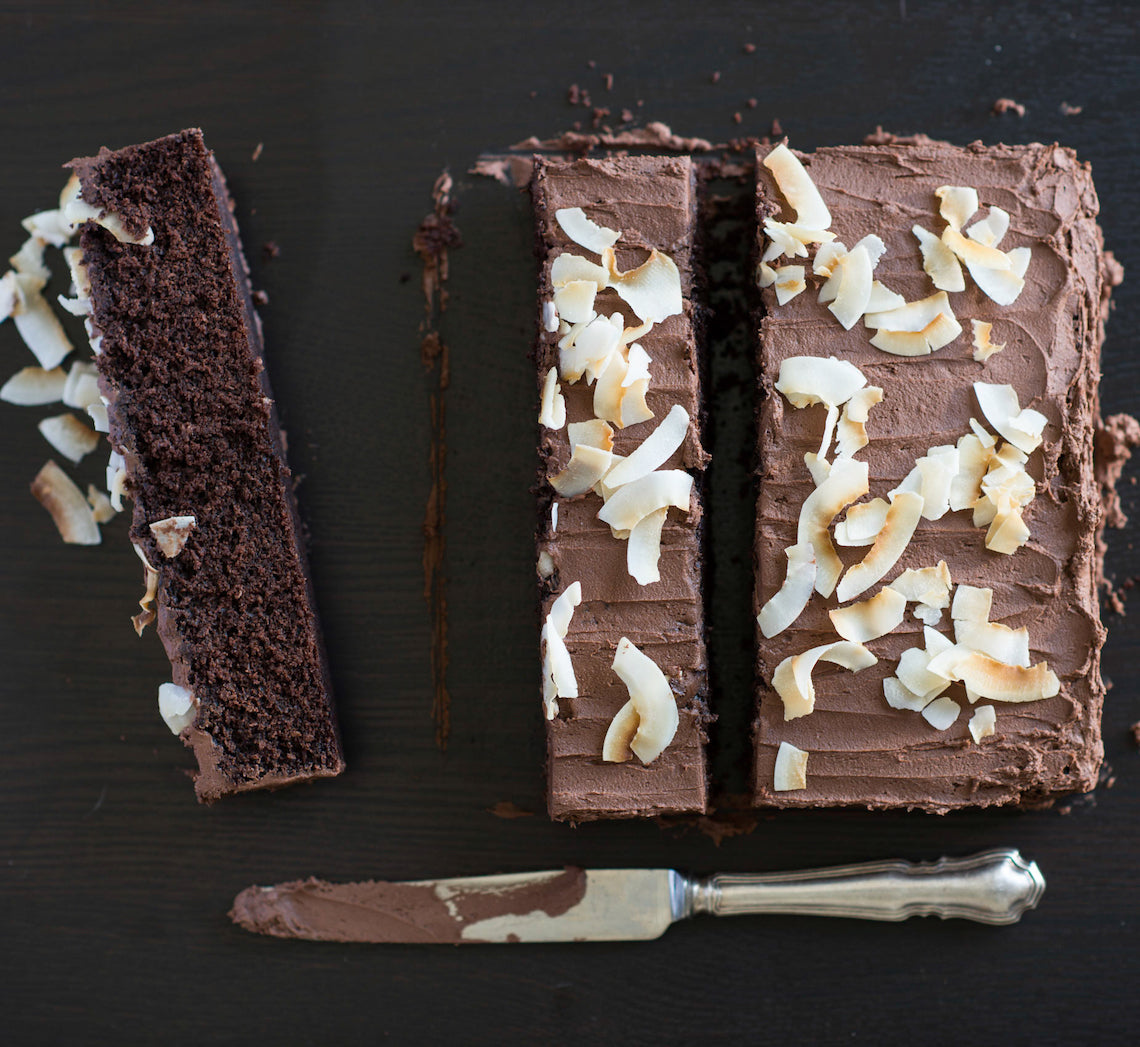
Prep 20min (+1hr 30min cooling time)Bake 30-35minMakes 10-12 serves
Everyone needs a good old-fashioned chocolate cake in their repertoire that is easy enough to whip up on a whim. Made with a simple melt-and-mix method this delicious cake is a real crowd-pleaser.
Ingredients
Melted butter, to grease
125g salted butter, diced, at room temperature
220g (1 cup) caster sugar
185ml (¾ cup) milk
2 eggs, at room temperature, lightly whisked
2 teaspoons natural vanilla essence or extract
150g (1 cup) self-raising flour
55g (½ cup) cocoa powder
1 teaspoon baking powder
45g (½ cup) desiccated coconut
Chocolate buttercream
125g salted butter, at room temperature
185g (1½ cups) icing sugar mixture, sifted
2 tablespoons cocoa powder, sifted
Method
- Preheat oven to 180°C (160°C fan-forced). Grease a square 20cm cake tin with melted butter and line the base with non-stick baking paper.
- Combine the butter, sugar and milk in a medium saucepan. Stir over medium heat until butter melts, sugar dissolves and mixture is combined (see Baker's Tips). Remove from heat and use a fork to whisk in the eggs and vanilla.
- Sift together the flour, cocoa powder and baking powder into a large bowl. Stir in the coconut. Add the butter mixture and use a balloon whisk to stir until just combined.
- Spoon the mixture into the prepared tin and use the back of a metal spoon to smooth the surface. Bake in preheated oven for 30-35 minutes or until a skewer inserted into the centre of the cake comes out clean. Stand in the tin for 5 minutes before turning onto a wire rack to cool (this will take about 1½ hours).
- To make the Chocolate buttercream, use an electric mixer to beat the butter, icing sugar and cocoa powder in a medium bowl until pale and creamy and it is a smooth spreadable consistency. Spread the cooled cake with the buttercream and cut into portions to serve.
Baker's Tips
- Don’t overheat the butter mixture – as soon as the butter melts and the sugar has dissolved, remove it from the heat.
- This cake will keep in an airtight container at room temperature in a cool spot for up to 3 days.
This recipe is from Anneka's SBS Food online column, Bakeproof: Easy Chocolate Cakes. CLICK HERE for more Bakeproof recipes.
Photography by Alan Benson.
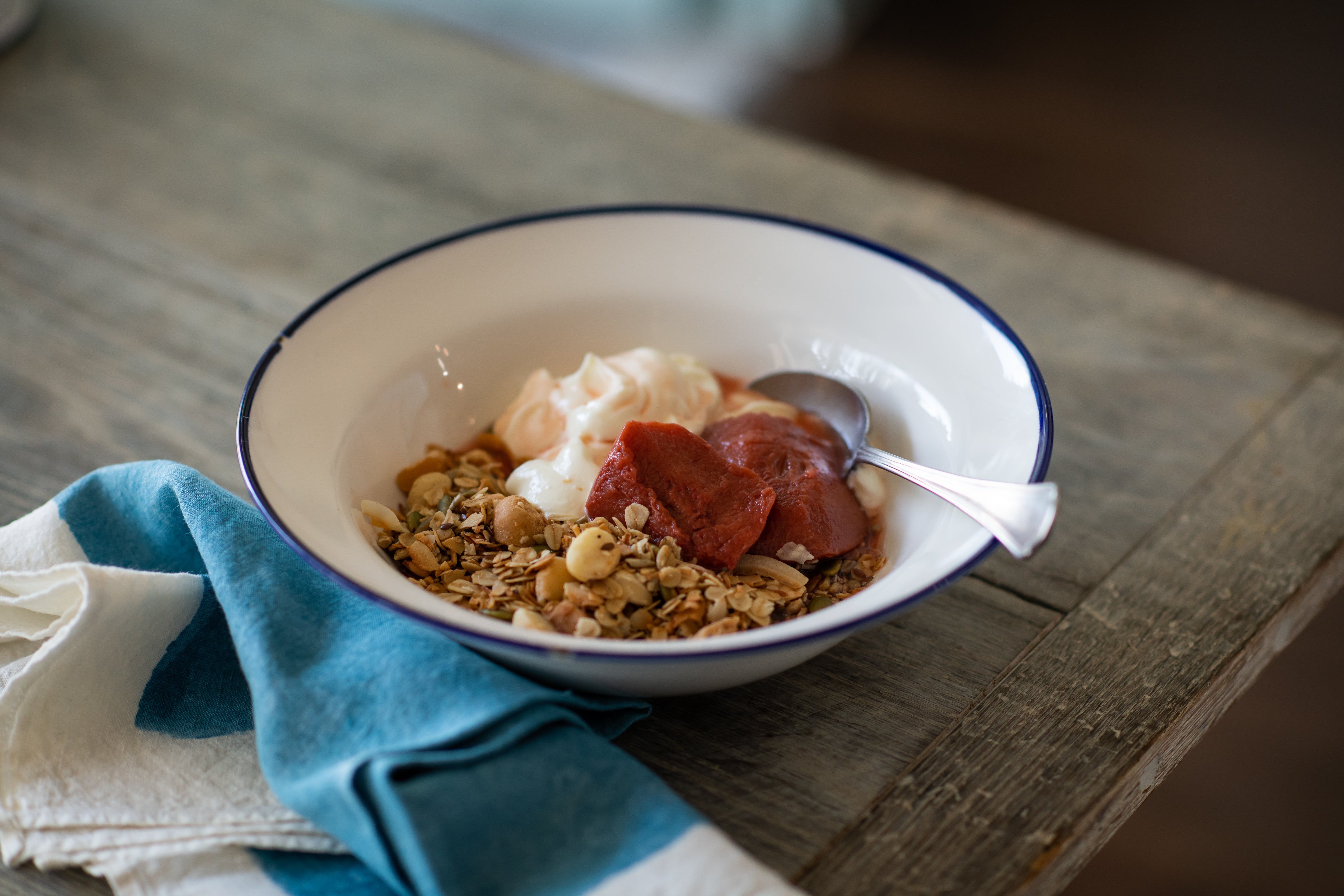
Prep 15minBake 30-40minMakes 1kg
Scrumptious and satisfying, this granola recipe is one that Make Me a Baker graduate, Sarah Taylor, serves at her cafe Six Smith in Cronulla on Sydney's southern beaches. If you would like to serve it just as Sarah does, greek-style yoghurt and seasonal fruit, such as oven-baked rhubarb, pears or apples, will make the perfect accompaniment.
Ingredients
275g rolled oats
75g sunflower seeds
75g coconut chips / flakes
75g shredded coconut
75g pepitas
25g white chia seeds
25g black chia seeds
25g poppy seeds
200g unsalted macadamias
60g maple syrup
60g almond oil
Method
- Preheat the oven to 170°C (150°C fan-forced).
- Combine all ingredients except the maple syrup and almond oil in a large bowl. Set aside.
- Heat the maple syrup and almond oil in a small saucepan over a low heat until warmed through and and combined. Pour over the rolled oats mixture and mix thoroughly until combined and evenly coated.
- Spread the oat mixture evenly over 2 medium shallow baking trays and bake in preheated oven for 30-40 minutes, stirring every 10 minutes, until golden and aromatic.
Baker's tip
- This granola will keep well in an airtight container or jar for up to 4 weeks.
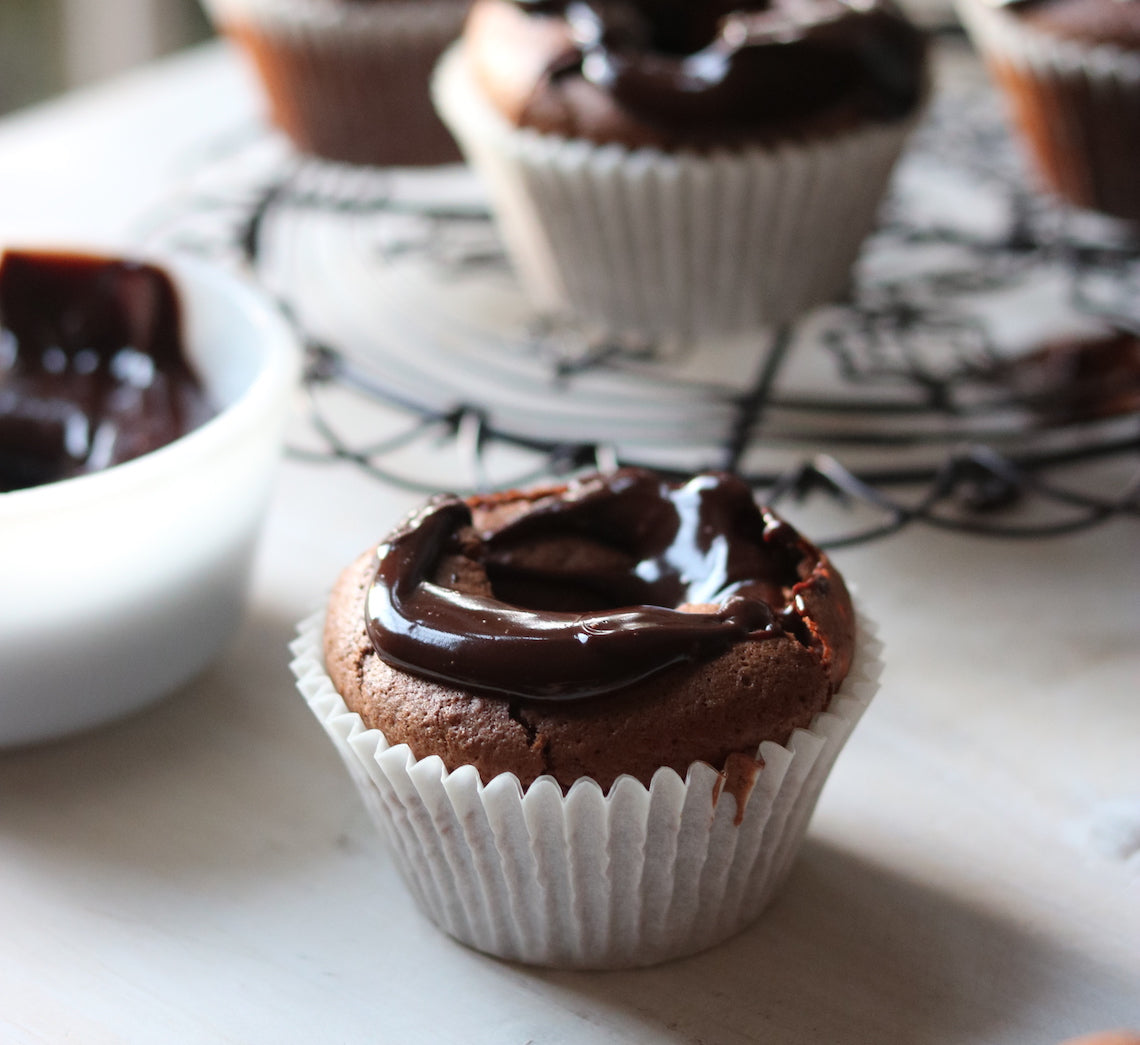
Prep 25minBake 30-35minMakes 12
Drizzled with an oozing chocolate ganache, these cupcakes are wickedly rich (but light in texture) and have a surprise of intense raspberry tartness hidden right in the middle!
Don't worry, you haven't done anything wrong – these cupcakes are meant to have a hole in the centre... Because the mixture is flourless, the raspberry jam sinks during baking creating a crater of sorts, giving them their name.
Ingredients
180g good-quality dark chocolate (45% or 70% cocoa), chopped (see Baker's Tips)
125g butter, cubed
60ml (1/4 cup) water
220g (1 cup) brown sugar, plus 2 tablespoons extra
85g (3/4 cup) hazelnut meal
25g (1/4 cup) desiccated coconut
3 eggs, at room temperature, separated
85g (1/4 cup) raspberry jam
Chocolate ganache
180g good-quality dark chocolate (45% cocoa), finely chopped
60ml (1/4 cup) pure (pouring) cream
Method
- Preheat the oven to 180°C (160°C fan-forced). Line a 12-hole 80ml (⅓ cup) muffin tin with paper cases.
- Combine the chocolate, butter and water in a medium saucepan and stir over a low heat until melted and smooth. Remove from heat, add the sugar, hazelnut meal, coconut and egg yolks and stir well with a wooden spoon until well combined and any lumps have broken up. Transfer the mixture to a large bowl.
- Place the egg whites in a clean, dry medium bowl and use electric beaters with a whisk attachment to whisk until soft peaks form. Add the extra 2 tablespoons of brown sugar and whisk until thick and glossy. Add a large spoonful of egg white mixture to the chocolate mixture and use a large metal spoon or spatula to fold in – this will ‘loosen’ the mixture. Add the remaining egg white mixture and fold in until just combined.
- Divide the mixture among the prepared muffin holes. Place a teaspoon of raspberry jam in the centre of each cupcake and press down gently until the jam is in line with the top the cupcake mixture. Bake in preheated oven for 30-35 minutes or until the top of the cupcakes feels set and crumbs cling to a skewer inserted into the side of a cupcake. Remove the cupcakes from the oven, and stand in the tray for at least 5 minutes before transferring to place a wire rack and cool completely.
- To make the Chocolate Ganache, place the chocolate in a heatproof bowl. Place the cream in a small saucepan and heat over medium heat, stirring occasionally, until the cream almost comes to a simmer. Pour the hot cream over the chocolate and set aside to stand for 3 minutes. Stir the chocolate and cream mixture until the chocolate melts and the mixture is smooth. Set aside, stirring occaiosnally until thickened to a thick pouring consistency (see Baker's Tips).
- Drizzle a generous spoonful of ganache on the tops of the cupcakes around the hole in the centre, allowing it to dribble over the sides and down into the hole. Set aside for about 30 minutes or until the ganache sets before serving.
Baker's Tips
- Using 70% cocoa chocolate in the cupcakes will give them a more intense chocolate flavour.
- The ganache will take between 15 minutes and about 11/2 hours to reach the right consistency for drizzling depending on the weather. If it is a really hot day you can put the ganache in the fridge to help it thicken - just make sure you stir it often so lumps don't form.
- These cupcakes will keep in an airtight container in a cool spot (but not in the fridge) for up to 3 days.
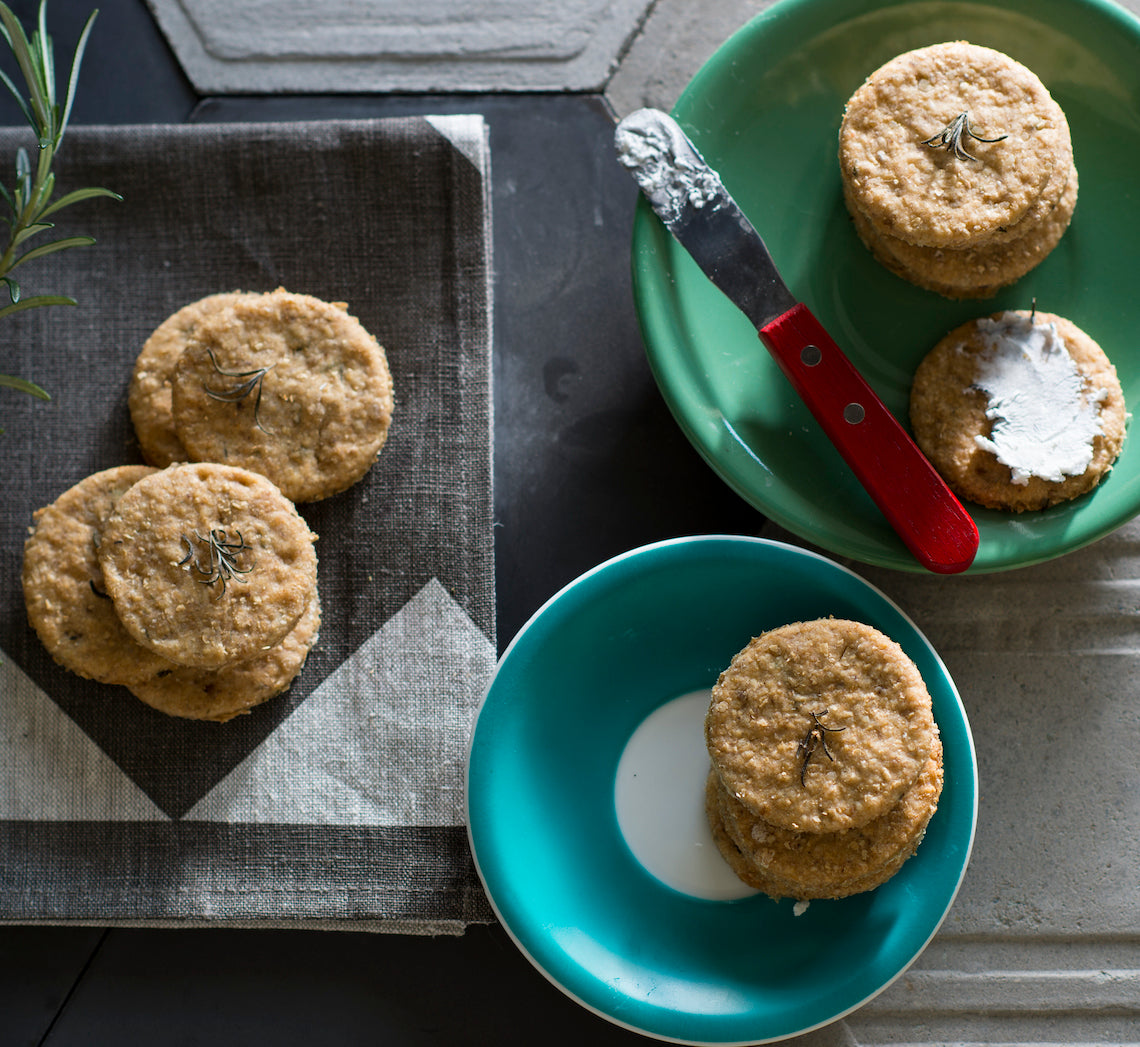
Prep 20min (+20min cooling time)Bake 18-20minMakes about 40
These crackers have a lovely nuttiness (thanks to both the wholemeal flour and walnuts) to them, perfect to serve with a creamy blue-vein cheese. They would also make a great gift, sealed in an airtight jar and accompanied by some cheese and a good bottle of red.
Ingredients
225g (1½ cups) plain wholemeal flour, plus extra for dusting100g walnuts, coarsely ground
2 teaspoons finely chopped rosemary, plus 2 teaspoons extra leaves, to sprinkle
1 teaspoon sea salt flakes, crushed
½ teaspoon baking powder
125ml (½ cup) water
2 tablespoons olive oil
1 tablespoon honey, warmed slightly
Method
- Preheat oven to 180°C (160°C fan-forced). Line 2 large oven trays with non-stick baking paper.
- Combine the flour, walnuts, rosemary, salt and baking powder in a large mixing bowl. Combine the water, olive oil and honey and use a fork to mix. Add the water mixture to the dry ingredients and use a wooden spoon and then your hands to mix to a soft dough.
- Turn the dough onto a lightly floured surface and knead briefly until smooth. Divide the dough in half and use a lightly floured rolling pin to roll out one portion until 5mm thick. Use a 6cm round cutter to cut out discs and place on the lined trays about 2cm apart. Repeat with the remaining dough portion and any offcuts. Sprinkle the crackers with the extra rosemary leaves to garnish, and press lightly so they stick.
- Bake in preheated oven for 18-20 minutes, swapping the trays around halfway through baking, or until golden and cooked through. Cool on the trays.
Baker's Tips
- These crackers will keep in an airtight container or jar at room temperature for up to 1 week.
This recipe is from Anneka's SBS Food online column, Bakeproof: Savoury Crackers.
CLICK HERE for more Bakeproof recipes.
Photography by Benito Martin.
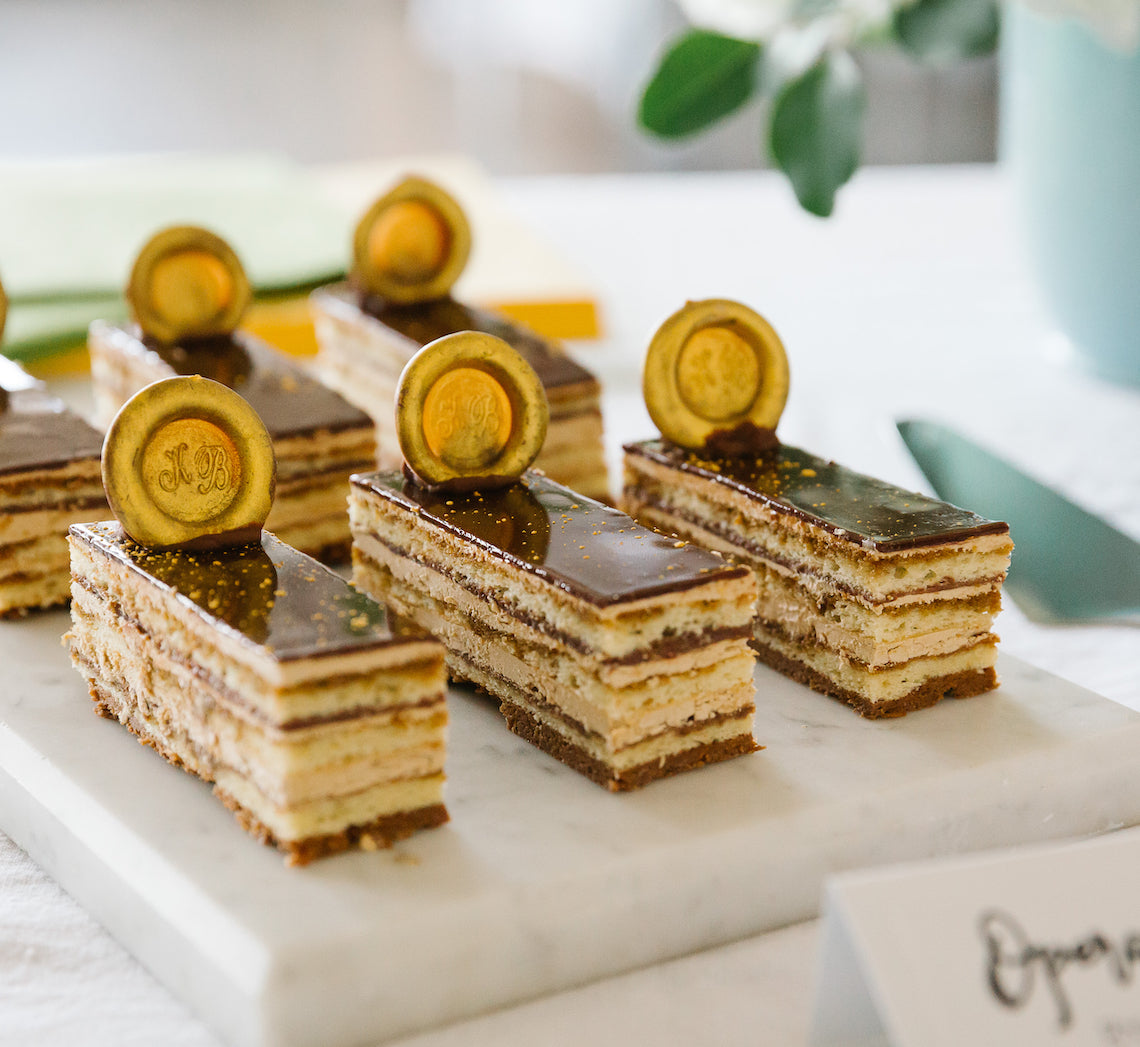
Prep 2hr (+ cooling time)Bake 8-10minMakes 18 serves
Created by Make Me a Baker student, Karthika Biju for her graduation, this stunning cake brings together numerous techniques learnt throughout the 6-month course. A real challenge, this dessert is an exquisite combination of chocolate and coffee-infused layers of almond sponge, ganache, chocolate croustillant, hazelnut praline and Swiss meringue buttercream. Karthika finished each portion of cake with gold dust and leaf and also personalised them with a chocolate disc monogramed with her initials. Not for the faint-hearted baker, this recipe is nothing short of a challenge but the results will definitely reflect the effort.
Ingredients
Edible gold leaf and dust, to decorateJoconde (Almond Sponge)
Melted butter, to grease5 eggs, at room temperature
140g almond meal
140g soft icing sugar mixture
30g plain flour
5 egg whites
30g caster sugar
¼ teaspoon salt
30g unsalted butter, melted
Coffee Syrup
160ml (2/3 cup) water100g caster sugar
3 teaspoons instant coffee powder
Hazelnut Praline Paste
125g whole raw hazelnuts75g caster white sugar
2 teaspoons water
¼ teaspoon salt
Chocolate Croustillant
40g good-quality dark chocolate (45% cocoa), chopped or callets30g Hazelnut Praline Paste
70g Paillette Feuilletine (see Baker’s Tips)
Chocolate Ganache
160g good-quality dark chocolate (45% cocoa), chopped or callets160ml (2/3 cup) thickened cream
Swiss Meringue Coffee Buttercream
4 egg whites, at room temperature200g caster sugar
1/2 teaspoon salt
250g unsalted butter, at room temperature
Coffee extract, to taste
Chocolate Glaze
6.6g gelatine leaves250ml (1 cup) chilled water
125ml (1/2 cup) room temperature water
225g caster sugar
150g good-quality dark chocolate (70% cocoa), callets or chopped
30g cocoa powder, sifted
65ml pure cream (35% butterfat)
Monogramed Chocolate Discs
70g good-quality dark chocolate (45% cocoa), callets or choppedEdible gold lustre paint (See Baker’s Tips)
Wax seal (kept in freezer for at least 45 minutes)
Joconde (Almond Sponge Cake)
- To make the Joconde, preheat the oven to 200°C (180°C fan-forced). Brush two 23cm x 33cm shallow baking trays with melted butter and line the base and sides of each with one piece of non-stick baking paper, cutting into the corners to fit.
- Sift the almond meal and icing sugar into a large bowl. Add the whole 5 eggs and use an electric hand mixer to mix until the mixture is creamy. Stir in the flour until just combined.
- Use an electric mixer with a whisk attachment on medium speed to whisk the egg whites and salt in a large clean bowl until soft peaks form. Gradually whisk in the sugar and continue to whisk until stiff peaks form. Use a spatula or large metal spoon to fold the egg whites through the almond mixture. Add the melted butter and fold gently together.
- Divide the batter evenly between the prepared tins. Bake in preheated oven for 8-10 minutes until lightly golden and cooked through. Cool in the tins.
- Carefully turn the cooled cakes onto a cutting board and cut each into one 20cm square and one 10cm x 20cm rectangle.
Coffee Syrup
- To make the Coffee Syrup, place the water, sugar and coffee into a small saucepan and stir over medium heat until the sugar dissolves. Bring to the boil then remove from heat and set aside to cool completely.
Caramel
- Place the sugar and water in a saucepan over low heat. Leave it to heat until the sugar has melted. Do not stir. Continue cooking until it has turned a golden caramel.
- Meanwhile, fill your sink with cold water. Once the caramel is ready, dip the base of the saucepan in the cold water for a few seconds to stop the cooking process. Set the pan on a towel on the bench.
Hazelnut Praline Paste
- To Make the Hazelnut Praline Paste, reduce the oven temperature to 180°C (160°C fan-forced) and roast the hazelnuts for 10-15 minutes, stirring them every 5 minutes, or until aromatic and the skins start to crackle.
- Wrap the warm hazelnuts in a tea towel and set aside to steam for 10 minutes. Use the tea towel to rub to hazelnuts against it and each other to remove the skins.
- Line an oven tray with non-stick baking paper or a silicone mat. Place the sugar and water in a small heavy-based saucepan and stir over medium heat until the sugar dissolves. Bring to a simmer and simmer over medium heat, brushing down the sides of the saucepan with a pastry brush dipped in water to remove any sugar crystals from the sides of the pan, until a deep golden toffee forms. Remove from the heat add the toasted skinned hazelnuts but don’t stir. Pour immediately onto the lined tray and set aside to cool completely.
- When the toffee is cool, break into small pieces. Add about a quarter of the toffee shards to a food processor bowl and process until ground. With the motor running, add the remining toffee shards and process until ground. Add the salt and continue to process until a smooth paste with a peanut butter consistency forms (see Baker’s Tips).
Chocolate Hazelnut Croustillant
- To make the Chocolate Croustillant, place the chocolate in a heatproof bowl and place over a saucepan of barely simmering water (don’t let the base of the bowl touch the water). Stir occasionally until melted and smooth.
- Add Pailleté Feuilletine and Hazelnut Praline Paste to the melted chocolate and stir to combine. Spread the croustillant over the 20cm square layer of sponge cake on the board. Place in the fridge to set
Chocolate Ganache
- To make the Chocolate Ganache, place the chocolate in a heatproof bowl. Heat cream in a small saucepan over medium heat and bring just to the boil.
- Pour the cream over the chocolate and set aside for 1 minute. Stir until smooth. Set aside to cool at room temperature, stirring occasionally, until it thickens to a peanut butter consistency (see Baker’s Tips).
Coffee Buttercream
- To make the Coffee Buttercream, combine the egg whites, sugar and salt in a medium heatproof bowl. Place the bowl over a pan of simmering water (don’t let the base of the bowl touch the water). Use a balloon whisk to stir until the sugar dissolves. Continue to stir until the mixture reaches 70°C on a thermometer.
- Transfer the mixture to the bowl of a stand mixer and whisk on high speed with the whisk attachment until the mixture is very thick and glossy and has cooled completely to room temperature.
- Replace the whisk with the paddle attachment and gradually add the room temperature butter a tablespoon at a time, beating well on medium-high speed after each addition, before adding the next lot. Once all the butter has been incorporated, beat in the coffee extract.
Cake Assembly
- Remove the croustillant-coated sponge cake layer from the fridge and carefully flip it onto a on a another cutting board with chocolate croustillant facing down. Brush the sponge with about a third of the coffee syrup and then spread with half of the coffee buttercream. Place the two 10cm x 20cm sponge layers side by side on top to cover and brush with half of the remaining coffee syrup.
- Reserve about 1/4 cup of the ganache and spread the sponge evenly with the remaining chocolate ganache. Top with the remaining layer of sponge cake and brush well with the remining coffee syrup. Spread with the remaining buttercream to cover and even the surface using an offset spatula or cake scraper. Cover and refrigerate the cake for at least 2 hours or overnight.
Monogramed Chocolate Discs
- Line a tray with non-stick baking paper. Remove the wax seal from the freezer and place in a bowl of ice.
- Melt the chocolate in the microwave for 10 seconds bursts on high, stirring well after each burst until the chocolate is completely melted. Spoon the chocolate into a zip-lock bag and cut a small hole in one corner. Working quickly, pipe the chocolate onto the lined try to form three discs, each about the size of a dollar coin. Immediately use the chilled wax seal to imprint the chocolate discs, holding on each for 5 seconds. Place the seal back in the ice (see Baker’s Tips) and repeat with the remaining chocolate making and imprinting three discs at a time. Set aside at room temperature to set and firm.
- Once set use a small paintbrush to paint each disc with edible lustre gold paint to coat.
Chocolate Glaze
- When ready to glaze the cake, carefully transfer the cake to a rack over a tray lined with baking paper. Return to the fridge.
- To make the Chocolate Glaze. Place the gelatine sheets in a bowl and add 250ml (1 cup) of the chilled water to cover. Set aside.
- Place the chocolate in a medium heatproof bowl. Combine the remaining 125ml (1/2 cup) water in a small saucepan with the sugar. Stir over medium heat until the sugar dissolves. Bring to the boil and boil gently, brushing down the sides of the pan with a pastry brush dipped in water to dissolve any sugar crystals, until the syrup reaches 104°C on a thermometer.
- Remove the syrup from the heat and pour over the chocolate. Stir until the chocolate melts and the mixture is smooth. Sift the cocoa powder over the chocolate mixture and use a balloon whisk to stir until combined and smooth. Add the cream and stir until the mixture cools to 60°C on a thermometer.
- Use your hands to squeeze as much water as possible from the gelatine sheets and add to the warm chocolate mixture. Stir until dissolved.
- Transfer the mixture to a jug anduse a stick blender to blend until the mixture is emulsified and smooth. Strain the glaze through a fine mesh sieve.
- Once the glaze cools to 32°C on a thermometer pour it immediately over the chilled cake to create a smooth surface, allowing any excess to drip down the sides. Refrigerate for about 1 hour or until the glaze is set.
To Serve
- Use a hot, dry knife trim the edges of the cake and then cut into 18 pieces (each about 7cm x 3cm). Transfer to a serving plate. Soften the reserved Chocolate Ganache by heating in 10 second bursts on high and stirring between each burst until smooth. Cool until almost a piping consistency. Spoon into a piping bag fitted with a small star nozzle. Pipe a rosette of ganache at the end of each cake portion and rest a Monogramed Chocolate Disc against the rosette to hold it. Decorate with gold leave and dust as desired.
Baker's Tips
- Paillette Feuilletine is fine broken shards of Crêpes Dentelle (a crisp biscuit made from rolled crêpes)and is used to add texture to confections and desserts. It is available from specialty food stores and French delicatessens.
- Edible lustre gold paint is available from specialty cake decorating shops and suppliers and some craft stores.
- The Hazelnut Praline Paste will be coarse crumbs in the beginning, but it will eventually get smooth with processing. Don’t add water to thin the mixture but a little vegetable oil can be added to reach the right consistency is needed.
- The longer the Chocolate ganache stands at room temperature the thicker it will become. It is ready to use when it becomes a peanut butter-like consistency. If left for too long, it will become too thick to spread.
- The wax seal must be left in the ice between imprinting the discs for it to work effectively and not stick to the chocolate.
Karthika based this recipe on one from https://www.homecookingadventure.com.






